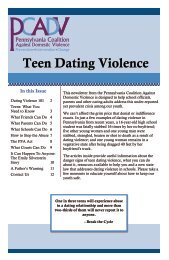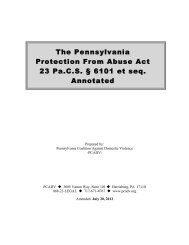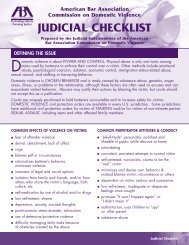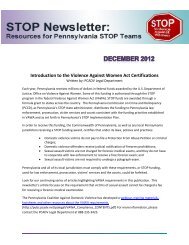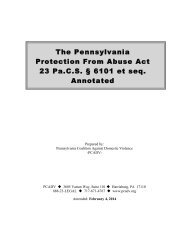Toolkit with Report Form - Pennsylvania Coalition Against Domestic ...
Toolkit with Report Form - Pennsylvania Coalition Against Domestic ...
Toolkit with Report Form - Pennsylvania Coalition Against Domestic ...
Create successful ePaper yourself
Turn your PDF publications into a flip-book with our unique Google optimized e-Paper software.
Section seven<br />
Individual and<br />
Community Crisis Reaction<br />
An individual trauma is a “blow<br />
to the psyche that breaks through<br />
one’s defenses so suddenly and <strong>with</strong><br />
such force that one cannot respond<br />
effectively.”<br />
~ Kai T. Erikson, In the Wake<br />
of the Flood, 1979<br />
Communities can also experience trauma<br />
and react collectively. Every community<br />
will differ in its immediate and long-term<br />
reactions to a traumatic event. Factors<br />
influencing such reactions include:<br />
◗ Trauma history <strong>with</strong>in the community<br />
◗ Its identification of risk and preparation for<br />
traumatic events prior to any trauma<br />
◗ The duration of the trauma<br />
◗ How the community responds to the<br />
traumatic event<br />
There is a patterned crisis reaction that<br />
occurs in all of us (as previously mentioned<br />
in Section 5). The long-term crisis reactions<br />
each person will experience vary and may<br />
be impacted by:<br />
◗ The immediate response in the<br />
aftermath of trauma<br />
◗ Trauma history<br />
◗ Age<br />
◗ Developmental stage<br />
◗ Life factors<br />
◗ Social support<br />
◗ Access to resources<br />
◗ Resiliency factors<br />
◗ Physical and cognitive abilities<br />
It is necessary to respond to<br />
communities in crisis to begin to undo<br />
the harm done and support the healing<br />
of all communities affected by the<br />
traumatic event.<br />
Leaders, responsible for the entire<br />
community or a smaller subset of the<br />
community, should recognize that diverse<br />
groups might react differently based on<br />
similar factors that influence individual crisis<br />
reactions. Recognizing the range of possible<br />
reactions will help communities respond<br />
and access the resources that are best<br />
suited for sub-communities that contribute<br />
to the strength of the overall social fabric.<br />
According to Erikson, collective trauma<br />
is a “blow to the tissues of social life<br />
that damages the bonds attaching<br />
people together.”<br />
page 50<br />
When Crisis Strikes | <strong>Pennsylvania</strong> <strong>Coalition</strong> <strong>Against</strong> <strong>Domestic</strong> Violence | 2012



